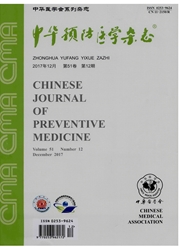

 中文摘要:
中文摘要:
目的调查上海市青少年互联网使用的现况和网络成瘾的发生率。方法采用分层整群随机抽样,于2007年9—10月对上海市6个区、16所学校的5135名在读的初中和高中阶段的学生进行互联网使用情况的问卷调查,采用《DRM青少年因特网使用情况调查52量表》。量表采用5级评分,从耐受性、戒断反应、计划性、控制性、时间性、社会性和危害性7个层面,分析上海市青少年互联网使用的总体情况、互联网使用的性别和年级间的差异。结果上海市青少年互联网使用率94.32%(4673/5123),网络成瘾率8.78%(450/5123)。男生比女生、高中生比初中生更倾向于网络成瘾(男生量表分值122.42±43.46,女生分值116.92±38.10;F=23.22,P=0.00。高中生分值125.24±39.02,初中生分值110.30±42.35。F=164.68,P=0.00),网络成瘾的倾向性职业高中学生最严重(初中生分值110.30±42.35,普通高中生分值122.83±40.99,重点高中生分值120.05±37.87,职业高中生分值133.37±36.84;F=34.44,P=0.00)。各年级分析显示,高二学生网络成瘾倾向最明显。网络成瘾倾向分别为高一大于初三(高一分值123.98±37.30,初三分值113.16±42.06;F=30.48,P=0.oo)和高二大于高三(高二分值127.26±40.27,高三分值122.52±38.60;F=6.40,P=0.01),初三大于初一(初三分值113.16±42.06,初一分值107.59±44.59;F=5.61,P=0.02)和高二大于高一(高二分值127.26±40.27,高一分值123.98±37.30;F=4.38,P=0.04)。结论上海青少年互联网使用率较高,应重视网络成瘾对青少年的不良影响,尤其在初二、初三阶段集中宣教、及早矫治可能会减少网络成瘾在上海市青少年中的发生。
 英文摘要:
英文摘要:
Objective To study the prevalence of internet use and internet addiction in adolescents of Shanghai. Method From September to October 2007, a total of 5135 adolescents from 16 middle schools of 6 districts of Shanghai took part in the epidemiological study by a cross-sectional survey and 5123 adolescents finally enrolled in the study. A questionnaire of "DRM Adolescent Internet Use 52 Scale" was administrated to investigate the prevalence of internet use and internet addiction in adolescents of Shanghai. On this scale of 5-point rating, the scale includes seven parts of contents as tolerance, abstinence reaction,planning ability,self-control ability,whenness,sociability and hazard. Results The rate of internet use among the surveyed adolescents was 94. 32% (4673/5123) , among which the incidence rate of internet addiction was 8. 78% (450/5123). Boys, senior middle-school students were more susceptible to internet addiction than girls and junior middle-school students (male scores 122. 42 ± 43.46, female scores 116. 92 ± 38.10, F = 23.22, P = 0. 00 ; senior middle-school students 125.24 ± 39. 02, junior middle-school students 110. 30 ± 42. 35, F = 164. 68, P = 0. 00 ) . Students from vocational senior middle-school were most susceptible (junior middle-school students 110. 30 ± 42. 35, ordinary senior middle-school students 122. 83 ± 40.99, key senior middle-school students 120.05 ± 37.87, vocational senior middle-school students 133.37 ±36. 84,F =34. 44,P =0. 00). The 2nd grade students of senior middle-school have the highest risk for internet-addiction. Conclusion The prevalence of internet use and internet addiction in adolescents of Shanghai should be comparatively high in China, which indicates that great attention should be paid to the prevention and control.
 同期刊论文项目
同期刊论文项目
 同项目期刊论文
同项目期刊论文
 期刊信息
期刊信息
